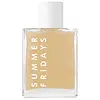What's inside
What's inside
 Key Ingredients
Key Ingredients

 Benefits
Benefits

 Concerns
Concerns

 Ingredients Side-by-side
Ingredients Side-by-side

Caprylic/Capric Triglyceride
MaskingMacadamia Ternifolia Seed Oil
EmollientSimmondsia Chinensis Seed Oil
EmollientCoco-Caprylate/Caprate
EmollientDicaprylyl Carbonate
EmollientPrunus Armeniaca Kernel Oil
MaskingHelianthus Annuus Seed Oil
EmollientSilica Cetyl Silylate
Parfum
MaskingTrihydroxystearin
Skin ConditioningEthylene/Propylene/Styrene Copolymer
Mica
Cosmetic ColorantCI 77891
Cosmetic ColorantCalcium Sodium Borosilicate
Butylene/Ethylene/Styrene Copolymer
Coumarin
PerfumingCI 77491
Cosmetic ColorantSilica
AbrasiveSynthetic Fluorphlogopite
BHT
AntioxidantTocopherol
AntioxidantTin Oxide
AbrasiveCaprylic/Capric Triglyceride, Macadamia Ternifolia Seed Oil, Simmondsia Chinensis Seed Oil, Coco-Caprylate/Caprate, Dicaprylyl Carbonate, Prunus Armeniaca Kernel Oil, Helianthus Annuus Seed Oil, Silica Cetyl Silylate, Parfum, Trihydroxystearin, Ethylene/Propylene/Styrene Copolymer, Mica, CI 77891, Calcium Sodium Borosilicate, Butylene/Ethylene/Styrene Copolymer, Coumarin, CI 77491, Silica, Synthetic Fluorphlogopite, BHT, Tocopherol, Tin Oxide
Paraffinum Liquidum
EmollientIsohexadecane
EmollientEthylene/Propylene/Styrene Copolymer
PPG-14 Butyl Ether
Skin ConditioningIsopropyl Palmitate
EmollientButylene/Ethylene/Styrene Copolymer
Parfum
MaskingCalcium Sodium Borosilicate
Prunus Amygdalus Dulcis Oil
Skin ConditioningHydroxystearic Acid
CleansingCalcium Aluminum Borosilicate
Silica
AbrasiveBenzyl Alcohol
PerfumingBenzyl Salicylate
PerfumingCoumarin
PerfumingHexyl Cinnamal
PerfumingLimonene
PerfumingLinalool
PerfumingCI 77891
Cosmetic ColorantCI 77499
Cosmetic ColorantCI 77491
Cosmetic ColorantMica
Cosmetic ColorantParaffinum Liquidum, Isohexadecane, Ethylene/Propylene/Styrene Copolymer, PPG-14 Butyl Ether, Isopropyl Palmitate, Butylene/Ethylene/Styrene Copolymer, Parfum, Calcium Sodium Borosilicate, Prunus Amygdalus Dulcis Oil, Hydroxystearic Acid, Calcium Aluminum Borosilicate, Silica, Benzyl Alcohol, Benzyl Salicylate, Coumarin, Hexyl Cinnamal, Limonene, Linalool, CI 77891, CI 77499, CI 77491, Mica
Ingredients Explained
These ingredients are found in both products.
Ingredients higher up in an ingredient list are typically present in a larger amount.
We don't have a description for Butylene/Ethylene/Styrene Copolymer yet.
Calcium Sodium Borosilicate is a bulking agent. It is considered a borosilicate glass; it is composed of powder or flakes of calcium and sodium borosilicates.
This ingredient is used to add volume, shine, and color to products. You'll most likely find this ingredient in makeup products.
According to in-vivo and ex-vivo studies done by a manufacturer, this ingredient works well with UV filters:
Learn more about Calcium Sodium BorosilicateCi 77491 is also hydrated iron III oxide. It's sole purpose is to give a red/pink hue to products.
Iron III oxides are classified as inorganic chemicals for coloring.
Synthetically created Ci 77491 is considered safer than those naturally found. This is because the synthetically created version may contain less impurities. Iron oxides are generally non-toxic and non-allergenic.
Learn more about CI 77491Ci 77891 is a white pigment from Titanium dioxide. It is naturally found in minerals such as rutile and ilmenite.
It's main function is to add a white color to cosmetics. It can also be mixed with other colors to create different shades.
Ci 77891 is commonly found in sunscreens due to its ability to block UV rays.
Learn more about CI 77891Coumarins are a group of substances found naturally in plants. There are over 1300 types of coumarins identified. It has a natural vanilla scent.
Coumarin is an identified EU known allergy, meaning it may cause an allergic reaction when applied to the skin.
In many countries, coumarin is banned as a food additive. However, it can be found in soaps, tobacco products, and some alcohol drinks.
Plants use coumarins as a chemical defense. Some plants that have coumarins include lavender, tonka beans, and yellow clovers.
Learn more about CoumarinWe don't have a description for Ethylene/Propylene/Styrene Copolymer yet.
Mica is a naturally occurring mineral used to add shimmer and color in cosmetics. It can also help improve the texture of a product or give it an opaque, white/silver color.
Serecite is the name for very fine but ragged grains of mica.
This ingredient is often coated with metal oxides like titanium dioxide. Trace amounts of heavy metals may be found in mica, but these metals are not harmful in our personal products.
Mica has been used since prehistoric times throughout the world. Ancient Egyptian, Indian, Greek, Roman, Aztec, and Chinese civilizations have used mica.
Learn more about MicaParfum is a catch-all term for an ingredient or more that is used to give a scent to products.
Also called "fragrance", this ingredient can be a blend of hundreds of chemicals or plant oils. This means every product with "fragrance" or "parfum" in the ingredients list is a different mixture.
For instance, Habanolide is a proprietary trade name for a specific aroma chemical. When used as a fragrance ingredient in cosmetics, most aroma chemicals fall under the broad labeling category of “FRAGRANCE” or “PARFUM” according to EU and US regulations.
The term 'parfum' or 'fragrance' is not regulated in many countries. In many cases, it is up to the brand to define this term.
For instance, many brands choose to label themselves as "fragrance-free" because they are not using synthetic fragrances. However, their products may still contain ingredients such as essential oils that are considered a fragrance by INCI standards.
One example is Calendula flower extract. Calendula is an essential oil that still imparts a scent or 'fragrance'.
Depending on the blend, the ingredients in the mixture can cause allergies and sensitivities on the skin. Some ingredients that are known EU allergens include linalool and citronellol.
Parfum can also be used to mask or cover an unpleasant scent.
The bottom line is: not all fragrances/parfum/ingredients are created equally. If you are worried about fragrances, we recommend taking a closer look at an ingredient. And of course, we always recommend speaking with a professional.
Learn more about ParfumSilica, also known as silicon dioxide, is a naturally occurring mineral. It is used as a fine, spherical, and porous powder in cosmetics.
Though it has exfoliant properties, the function of silica varies depending on the product.
The unique structure of silica enhances the spreadability and adds smoothness, making it a great texture enhancer.
It is also used as an active carrier, emulsifier, and mattifier due to its ability to absorb excess oil.
In some products, tiny microneedles called spicules are made from silica or hydrolyzed sponge. When you rub them in, they lightly polish away dead skin layers and enhance the penetration of active ingredients.
Learn more about Silica